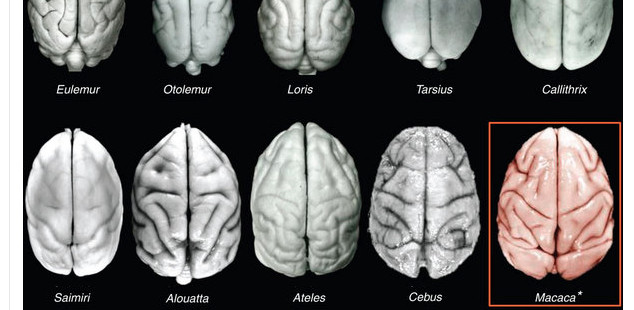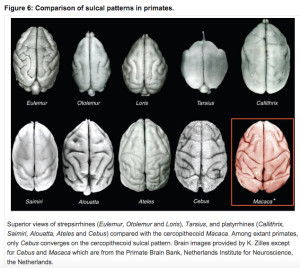
Brain Complexity vs. Brain Size in Primate Evolution
Nature Communications 6 (2015), no. 7580 doi:10.1038/ncomms8580
Cerebral complexity preceded enlarged brain size and reduced olfactory bulbs in Old World monkeys
Gonzalez, Lauren A., Brenda R. Benefit, Monte L. McCrossin, and Fred Spoor.
Analysis of the only complete early cercopithecoid (Old World monkey) endocast currently known, that of 15-million-year (Myr)-old Victoriapithecus, reveals an unexpectedly small endocranial volume (ECV) relative to body size and a large olfactory bulb volume relative to ECV, similar to extant lemurs and Oligocene anthropoids. However, the Victoriapithecus brain has principal and arcuate sulci of the frontal lobe not seen in the stem catarrhine Aegyptopithecus, as well as a distinctive cercopithecoid pattern of gyrification, indicating that cerebral complexity preceded encephalization in cercopithecoids. Since larger ECVs, expanded frontal lobes, and reduced olfactory bulbs are already present in the 17- to 18-Myr-old ape Proconsul these features evolved independently in hominoids (apes) and cercopithecoids and much earlier in the former. Moreover, the order of encephalization and brain reorganization was apparently different in hominoids and cercopithecoids, showing that brain size and cerebral organization evolve independently.
Apparently a small primate brain can develop complexity without increasing in size. This is not what the  standing assumption about hominin evolution has been. This is the main finding of the Gonzalez et al. 2015 paper. From the point of view of out-of-America I, it’s a bit of good news because it shows that a) brain complexification in primates did not start with apes but evolved earlier than previously thought; b) it started independently in Old World monkeys and New World monkeys (Cebus); c) its onset did not require a large brain. In addition to a slew of remarkable social and behavioral convergences shared between Platyrrhines and modern humans but lacking in big apes (see here), the lack of a strict linear correlation between the brain’s size in primates and its structural complexity signals a possibility that it’s the social (sex, kinship, age-rank, etc.) complexity of the population (and not its sheer size) that promoted brain complexity in primates and humans.
standing assumption about hominin evolution has been. This is the main finding of the Gonzalez et al. 2015 paper. From the point of view of out-of-America I, it’s a bit of good news because it shows that a) brain complexification in primates did not start with apes but evolved earlier than previously thought; b) it started independently in Old World monkeys and New World monkeys (Cebus); c) its onset did not require a large brain. In addition to a slew of remarkable social and behavioral convergences shared between Platyrrhines and modern humans but lacking in big apes (see here), the lack of a strict linear correlation between the brain’s size in primates and its structural complexity signals a possibility that it’s the social (sex, kinship, age-rank, etc.) complexity of the population (and not its sheer size) that promoted brain complexity in primates and humans.


“Apparently a small primate brain can develop complexity without increasing in size”.
Have you ever heard of Suzana Herculano-Houzel on this matter?
No, I haven’t. Thanks for the link.